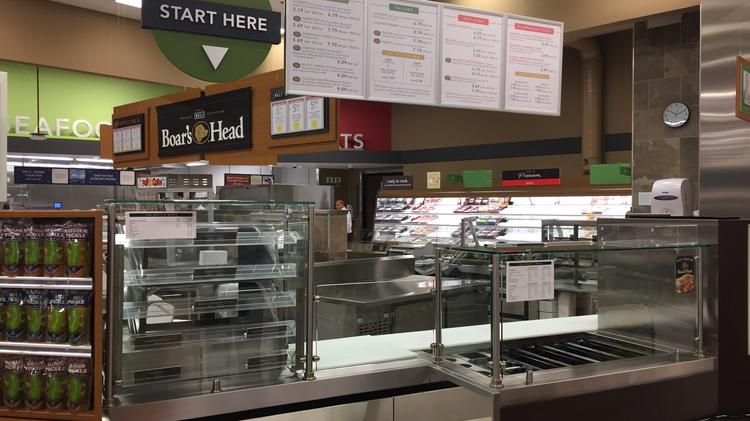If we have too many grocery stores, what does the future look like for Publix and Kroger?
The problems plaguing department stores and other mall-based retailers — too many locations and declining foot traffic — could be looming on the horizon for grocers like Publix Super Markets Inc. and Kroger Co.
From office supplies to clothing and accessories, retailers across the spectrum have shuttered physical storefronts in recent years to concentrate on their best-performing locations and online sales. Grocers, for the most part, have been immune from that dynamic, becoming the must-have anchor for new retail developments as a reliable way to draw regular foot traffic.
But as online ordering takes off and grocers shift their focus toward prepared foods, some industry observers think that big-box, traditional grocery stores could meet the same fate as department stores like Macy's Inc. (NYSE: M), which has been struggling to rightsize its physical footprint for years.
"We've probably got two or three times as many supermarkets, or at least the square footage, as we need," said Jim Hertel, senior vice president at Chicago-based food retailing consultancy Willard Bishop, an Inmar Analytics Co.
Several factors are behind that theory, Hertel said, from retailers like Target Corp. (NYSE: T) and Walgreens stepping up their grocery offerings to grocers like Kroger and Publix trying out new formats.
Lakeland-based Publix is the largest private employer in the Tampa Bay region, with 36,400 local employees and more than 180,000 throughout the Southeast. Kroger, based in Cincinnati, is one of Publix's biggest competitors in metro Atlanta and the Carolinas.
The new Publix store in downtown St. Petersburg — which is basically a restaurant attached to a grocery store— is an example of the kind of store that will take center stage in the industry in the coming years, Hertel said. That 30,000-square-foot store, with a large emphasis on prepared foods, will be the key to future growth, along with small-format discount grocers like Aldi and Lidl, both of which have aggressive expansion plans in the U.S.
As those stores take off, Hertel believes grocers will slow their development of the traditional, 55,000-square-foot big-box stores.
"That’s the part of the market that is most over-stored," Hertel said. "The growth is coming on the periphery."
'What are you doing with your square footage to adapt?'
In Hillsborough and Pinellas counties, there are 273 grocery stores, totaling 11.37 million square feet, according to data from CBRE Group Inc. That's one grocery store for every 8,421 residents.
On average, it takes 20,000 people to support one grocery store, said Mark Thompson, managing director with Crossman & Co. in Orlando, who specializes in grocer-anchored real estate.
By Thompson's count, Florida has around 1,700 grocery stores for a statewide population of 20 million people, or one store for every 11,500 residents.
Tourists, Thompson says, make up the difference. While the state hasn't yet released final tourism numbers for 2016, Florida was on pace to hit 115 million annual visitors as of November.
"Grocers are changing their formats to make adjustments for the needs of the consumer," said Thompson, who also runs GroceryAnchored.com. "And they’re doing it faster than any other box retailer."
Many of those adjustments are centered on making fresh and prepared foods front and center. Lucky's Market, which is backed by Kroger and on a major growth push in Florida, hosts in-store beer and wine tastings. Sprouts Farmers Market Inc. (NASDAQ: SFM), which recently opened its first Florida store in Tampa, also boasts an impressive selection of prepared foods.
Last year, Whole Foods Market Inc. (NASDAQ: WFM) piloted a food truck test kitchen at its flagship Austin, Texas, store. Some Publix stores feature space for cooking classes and event planning services.
"I think that’s the story — what are you doing with your square footage to adapt?" Thompson said.
Becoming a destination
Paul Rutledge, a first vice president with CBRE in Tampa, recently visited the new Sprouts store in Tampa on "Double Ad Wednesday" — the day that the grocer features overlapping weekly promotions.
"It was very, very busy," he said.
Sprouts is on a busy stretch of North Dale Mabry Highway in Carrollwood, in a shopping center where its biggest neighbors include a Target store and DSW Inc.
Publix and a Wal-Mart Stores Inc. location are across the street.
It's not a terrible location by any measure, but it isn't one of the region's most in-demand retail corridors. When Trader Joe's entered the Tampa Bay region in 2014, it did so with locations in South Tampa and St. Petersburg's Fourth Street North. (Sprouts will open a South Tampa store just over a half mile from Trader Joe's later this year.)
For Rutledge, the crowds at Sprouts reaffirm his thoughts on the future of grocery: Becoming a destination, and even a gathering place in some instances, will be key.
"It just goes to show you, the picture is more important than the frame," he said.
He points to Lucky's — a client of his — which he says is "hitting it out of the park" in Florida with its prepared foods and events centered around beer and wine.
Like Hertel, he sees small-format specialty stores as growth instrument for grocers moving forward, particularly as millennials age and exert their spending power. But it's not an easy format to nail, and as Thompson points out, it's one that's ever changing to adapt to consumer tastes.
"That's why everybody is scrambling," he said. "There are changing plates under the Earth, and everything is moving."

No comments:
Post a Comment